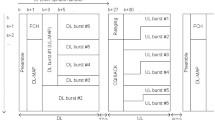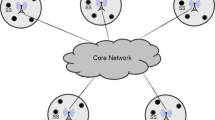Abstract
The fluctuation of available link bandwidth in mobilecellular networks motivates the study of adaptive multimediaservices, where the bandwidth of an ongoing multimedia call can bedynamically adjusted. We analyze the diverse objectives of theadaptive multimedia framework and propose two bandwidth adaptationalgorithms (BAAs) that can satisfy these objectives. The firstalgorithm, BAA-RA, takes into consideration revenue and``anti-adaptation'' where anti-adaptation means that a user feelsuncomfortable whenever the bandwidth of the user's call ischanged. This algorithm achieves near-optimal total revenue withmuch less complexity compared to an optimal BAA. The secondalgorithm, BAA-RF, considers revenue and fairness, and aims at themaximum revenue generation while satisfying the fairnessconstraint defined herein. Comprehensive simulation experimentsshow that the difference of the total revenue of BAA-RA and thatof an optimal BAA is negligible. Also, numerical results revealthat there is a conflicting relationship between anti-adaptationand fairness.
Similar content being viewed by others
References
M. Naghshineh and M. Willebeek-LeMair, “End-to-End QoS Provisioning in Multimedia Wireless/Mobile Networks Using an Adaptive Framework”, IEEE Communications Magazine, Vol. 35, No. 11, pp. 72–81, 1997.
V. Bharghavan, K. Lee, S. Lu, S. Ha, J. Li and D. Dwyer, “The TIMELY Adaptive Resource Management Architecture”, IEEE Personal Communications Magazine, Vol. 5, No. 4, pp. 20–31, 1998.
A.K. Talukdar, B.R. Badrinath and A. Acharya, “Rate Adaptation Schemes in Networks with Mobile Hosts”, in Proc. of ACM/IEEE MobiCom’ 98, Oct. 1998, pp. 169–180.
S.K. Das and S.K. Sen, “Quality-of-Service Degradation Strategies in Multimedia Wireless Networks”, in Proc. of IEEE Vehicular Technology Conference (VTC’ 98), Ottawa, May 1998, pp. 1884–1888.
K. Lee, “Adaptive Network Support for Mobile Multimedia”, in Proc. of ACM MobiCom’ 95, 1995, pp. 62–74.
S. Chakrabarti and R. Wang, “Adaptive Control for Packet Video”, in Proc. of IEEE International Conference on Multimedia Computing and Systems, May 1994, pp. 56–62.
N. Duffield, K. Ramakrishnan and A. Reibman, “SAVE: An Algorithm for Smoothed Adaptive Video over Explicit Rate Networks”, IEEE/ACM Transaction on Networking, Vol. 6, No. 6, pp. 717–728, 1998.
S. McCanne, M. Vetterli and V. Jacobson, “Low-Complexity Video Coding for Receiver-Driven Layered Multicast”, IEEE Journal on Selected Areas in Communications, Vol. 15, No. 6, pp. 983–1001, 1997.
J. Hartung, A. Jacquin, J. Pawlyk and K. Shipley, “A Real-Time Scalable Video Codec for Collaborative Applications over Packet Networks”, in Proc. of ACM Multimedia’ 98, Bristol, Sept. 1998, pp. 419–426.
T. Shanableh and M. Ghanbari, “MPEG to H.263 Video Transcoder”, in Proc.of Packet Video'99, New York, Apr. 1999.
K. Pahlavan and A.H. Levesque, Wireless Information Networks, Wiley-Interscience: New York, NY, 1995.
T. Kwon, Y. Choi, C. Bisdikian and M. Naghshineh, “Call Admission Control for Adaptive Multimedia in Wireless/Mobile Networks”, in Proc. of ACM Workshop on Wireless Mobile Multimedia (WoWMoM’ 98), Dallas, Oct. 1998, pp. 111–116.
Nicholas Yeadon, “Filters: QoS Support Mechanisms for Multipeer Communications”, IEEE Journal on Selected Areas in Communications, Vol. 14, No. 7, pp. 1245–1262, 1996.
J. Gomez, A. Campbell and H. Morikawa, “A Systems Approach to Prediction, Compensation and Adaptation in Wireless Packet Networks”, in Proc. of ACM/IEEE International Workshop on Wireless and Mobile Multimedia (WoWMoM’ 98), Dallas, Oct. 1998, pp. 92–100.
C. Chao and W. Chen, “Connection Admission Control for Mobile Multiple-class Personal Communication Networks”, IEEE Journal on Selected Areas in Communications, Vol. 15, No. 8, pp. 1618–1626, 1997.
T. Kwon, J. Choi, Y. Choi, and S.K. Das, “Near Optimal Bandwidth Adaptation Algorithm for Adaptive Multimedia Services in Wireless/Mobile Networks”, in Proc. of IEEE VTC’ 99 Fall, Amsterdam, Sept. 1999, pp. 874–878.
S. Biswas and B. Sengupta, “Call Admissibility for Multirate Traffic in Wireless ATM Networks”, in Proc. of IEEE INFOCOM’ 97, Kobe, Apr. 1997, pp. 650–659.
K.W. Ross, Multiservice Loss Models for Broadband Telecommunication Networks, Springer: London, U.K., 1995.
E. Horowitz, S. Sahni and S. Rajasekaran, Computer Algorithms/C++, Computer Science Press: New York, NY, 1996.
Mahmoud Naghshineh and Mischa Schwarz, “Distributed Call Admission Control in Mobile/Wireless Networks”, in IEEE PIMRC’ 95, 1995, pp. 289–293.
M. MacDougall, Simulating Computer Systems: Techniques and Tools, MIT Press, 1987.
Author information
Authors and Affiliations
Rights and permissions
About this article
Cite this article
Kwon, T., Choi, Y. & Das, S.K. Bandwidth Adaptation Algorithms for Adaptive Multimedia Services in Mobile Cellular Networks. Wireless Personal Communications 22, 337–357 (2002). https://doi.org/10.1023/A:1020239803918
Issue Date:
DOI: https://doi.org/10.1023/A:1020239803918




